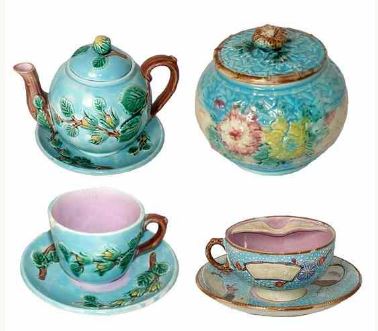Identification and Price guides for Antiques & Collectibles


COLLECTIBLE MAJOLICA POTTERY:
A Comprehensive Guide
Join the most updated and complete collectibles research online - Learn more...
 Majolica pottery is a type of earthenware that is characterized by its brightly colored, intricate designs and glazed finish. Originating in Italy during the Renaissance, this style of pottery quickly spread throughout Europe and became popular in the United States during the late 19th and early 20th centuries. Today, collectible majolica pottery is highly sought after by antique collectors and enthusiasts.
Majolica pottery is a type of earthenware that is characterized by its brightly colored, intricate designs and glazed finish. Originating in Italy during the Renaissance, this style of pottery quickly spread throughout Europe and became popular in the United States during the late 19th and early 20th centuries. Today, collectible majolica pottery is highly sought after by antique collectors and enthusiasts.
History of Majolica Pottery
Majolica pottery was first developed in the 16th century in Italy, specifically in the town of Faenza. The pottery was named after the island of Majorca, which was a major center of trade for ceramics during this time. The style quickly gained popularity throughout Europe, with many other countries, including Spain, Portugal, France, and England, producing their own versions of the pottery.
In the United States, majolica pottery became popular during the late 19th and early 20th centuries. Companies such as Wedgwood, Minton, and George Jones produced high-quality pieces that were highly sought after by collectors. Today, many of these pieces are considered rare and valuable.
Characteristics of Majolica Pottery
Majolica pottery is characterized by its bright colors and intricate designs. The pottery is typically made from earthenware, which is a type of clay that is fired at a relatively low temperature. The glaze used on majolica pottery is usually lead-based, which gives the pottery its distinctive shine.
Majolica pottery is also known for its relief work, which is achieved by molding the clay into intricate designs. The pottery is often decorated with images of animals, plants, and other natural elements. The designs are typically highly detailed and may include multiple layers of glaze to achieve a three-dimensional effect.
Collecting Majolica Pottery
If you are interested in collecting majolica pottery, there are several things to keep in mind. First, it is important to be able to recognize authentic pieces. Look for pieces that have a maker's mark or stamp, which will help you identify the manufacturer and date of production.
Second, consider the condition of the piece. Majolica pottery is known for its delicate glaze, which can easily be damaged. Look for pieces that are free from chips, cracks, and other damage.
Finally, be prepared to do some research. Majolica pottery can be highly collectible, and prices can vary widely depending on the rarity of the piece and the condition. Be sure to consult with experts and do your own research before making any purchases.
Popular Majolica Pottery Manufacturers
- Wedgwood - Wedgwood produced a range of majolica pottery during the late 19th century, including pieces featuring images of birds, fish, and other natural elements.
- Minton - Minton was known for producing highly detailed majolica pottery with intricate relief work. The company's pieces often featured images of flowers and foliage.
- George Jones - George Jones produced a wide range of majolica pottery, including pieces featuring images of animals, birds, and sea creatures.
Valuing Majolica Pottery
Valuing majolica pottery can be a complex process, as prices can vary widely depending on the rarity of the piece, the condition, and other factors. If you are looking to sell a piece of majolica pottery, it is important to consult with experts who can help you determine its value.
Some factors that can influence the value of majolica pottery include:
- Rarity
- Condition
- Age
- Manufacturer
- Design
- Size
Caring for Majolica Pottery
Majolica pottery is delicate and should be handled with care to avoid damage. To clean your majolica pottery, use a soft, damp cloth to gently wipe away any dust or dirt. Avoid using harsh cleaners or abrasives, which can damage the glaze or remove the paint.
If your majolica pottery does become damaged, it is best to seek out a professional conservator who can repair the piece without causing further damage.
Conclusion
Collectible majolica pottery is a beautiful and intricate art form that has been prized by collectors for centuries. Whether you are a seasoned collector or just starting out, there are many factors to consider when valuing and caring for your pieces. By following these tips and consulting with experts, you can build a collection of rare and valuable majolica pottery that will be enjoyed for generations to come.
Unlock the true value of your collection with our comprehensive research guides from identifying makers' marks to appraising all kinds of antiques and collectibles, including items featured in this article.
Our up-to-date information will give you an accurate understanding of your items' worth. Don't miss out on this valuable resource - visit our research tools today!
In addition to some examples shown below on this page, you can also search our price guide for your own treasures.
Examples of related items from our Price Guides
-
ITALIAN MAJOLICA SHALLOW BOWL, 18TH C., 12" [more like this]
-
PAIR OF MAJOLICA BLACKAMOOR FIGURESPair of [more like this]
-
TWO MAJOLICA PIECES AND TWO CERAMIC VASESProperty [more like this]
-
10 CONTEMPORARY CERAMIC DECORATIVE ARTICLESProperty [more like this]
-
4 PIECES OF ENGLISH MAJOLICA Property from [more like this]
-
UNMARKED STUMP-FORM MAJOLICA PLANTERProperty [more like this]
-
MAJOLICA COMPOTE AND 7 PLATESProperty from [more like this]
-
12 PIECES OF ENGLISH MAJOLICAProperty of [more like this]
-
11 PIECES OF ENGLISH MAJOLICAProperty of [more like this]
-
GROUP OF 7 PIECES OF UNMARKED MAJOLICAProperty [more like this]
-
SARREGUEMINES MAJOLICA CHARGER20th Century [more like this]
-
ANTIQUE MAJOLICA POTTERY WALL POCKETAntique [more like this]
There are many more auction results available to our members...
Explore more items from our
Antiques & Collectibles Price Guide
This list is limited to only a few results.
Many more items are available to our members through our
Price Guides!






